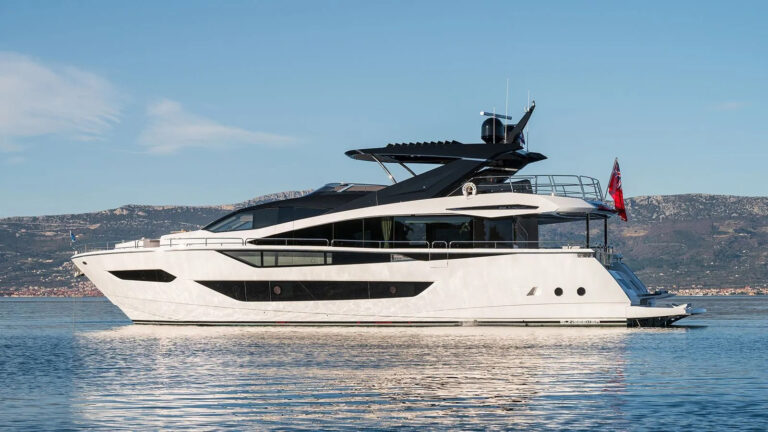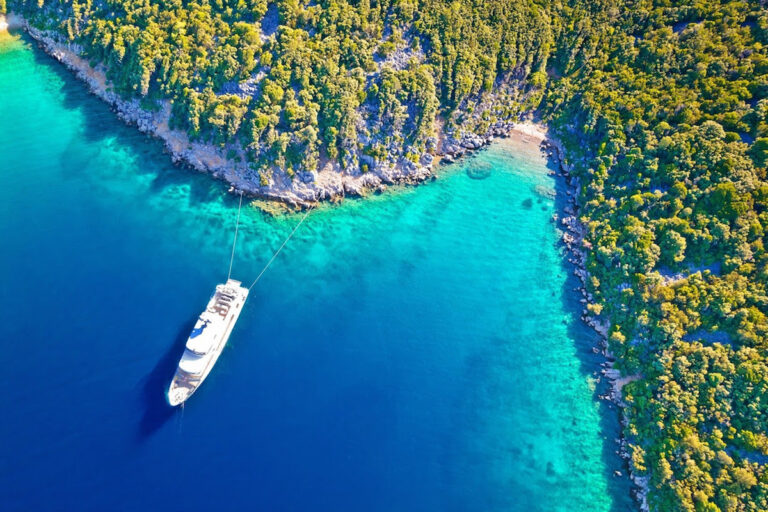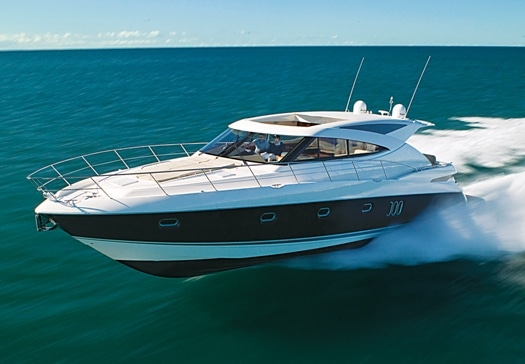
ytgjan4riv5800525.jpg
The majority of Riviera models we’ve covered previously in these pages reveal the Australian builder’s convertible roots. You kind of go with what you know, and it’s tough to argue that Australians don’t know sportfishing. The waters are full of large black marlin and the locals know a thing or two about raising them-and have built the boats to do it right. So it was with a bit of curiosity and a scratch of the head that I headed down the dock on Australia’s Gold Coast to take a look at the new Riviera 5800 Sport Yacht. This model didn’t represent their first foray into the competitive express style cruiser market, but it is certainly their most ambitious non-convertible project to date. The earlier models in the Sport Series are well executed, but to compete against a crowded group of formidable players coming primarily from Europe and the United States, the 5800 needed that wow factor-no half measures allowed.
In order to help ensure its success, the builder turned to Volvo and designed the 5800 with three 435-horsepower Volvo IPS 600s. This forward facing pod system first entered production in 2004. The early pioneers of IPS benefited from the propulsion system’s efficiencies and ease of maneuverability gained by the joystick control, but the benefits ended there. Although IPS units are placed further aft, no increased livability or interior volume was really gained, and for the most part there were just large, underutilized, fiberglass caverns where the engines used to be. Today, builders using the system are transitioning to a process where the IPS units are dictating the design.
On the 5800, the chief beneficiary is the accommodations. By placing the engines all the way aft, a huge lower deck is gained. Our test boat featured four staterooms, and three heads. A three-stateroom model is available that swaps the galley with a guest stateroom on the portside. Usually I’m not a fan of cramming too many staterooms into a space. Sure, it may work on a convertible where a place to rest your head on the way to the canyon takes precedent over comfort. On the 5800, however, the layout works and nothing is pinched. The portside guest stateroom is the smallest of the four, with single over and under bunks. Kids would be happy to call it home. The other staterooms will satisfy your more particular guests. The forward VIP cabin has an island double and an en suite head with separate shower stall. A twin berth stateroom to starboard has private access to an en suite head that, with access from the passageway, also works as a day head. I like the make up of these staterooms. Having a double, side-by side-twins, and bunks, should address just about any sleeping scenario. If required, the lazarette under the aft deck can be fitted out as crew accommodations. That means eight berths in addition to the master! That alone is not noteworthy-it’s the fact that all the spaces work. No sardines here.
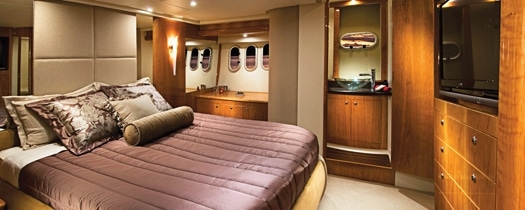
| | |
The master stateroom follows a trend that is popping up in other express styled boats-a full beam cabin. Previously, the common practice was to place the master up in the bow. With the space afforded by the IPS drives, however, express styled boats are graduating beyond simply big day boats. Six hull ports bring in large swaths of lights. This is another trend, but Riviera has managed to design theirs so they still look like they belong on a yacht. A vanity forward of the king berth will easily double as a laptop workstation. There is a straight settee and huge hanging locker to starboard. Designers kept the area light with a juxtaposition of pale fabrics against expertly executed cherry joinery.
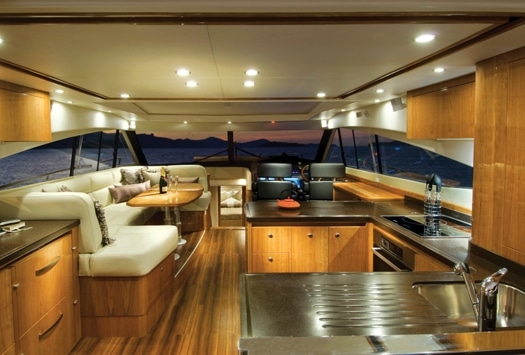
| | |
On the main deck, Riviera incorporates the same drop down aft bulkhead first introduced on the 3600 Sport Yacht. At rest, it makes a large, seamless entertainment platform between the galley and the aft deck. The U-shaped galley is very functional and far better than I’ve seen on express styled boats 20 feet larger. Our test boat was equipped with a Miele microwave, convection oven, and dishwasher. There is sufficient counter space to prepare a five-course meal, and by placing the four drawer-style refrigerator and freezer units to port, more than one person can work in the area. The forward end of the counter serves as a breakfast bar. If the down galley layout is selected, a second settee is placed in this area. Our test boat featured one large settee with a dining table to port that was more than enough, and underway provided perfect lines of sight forward.
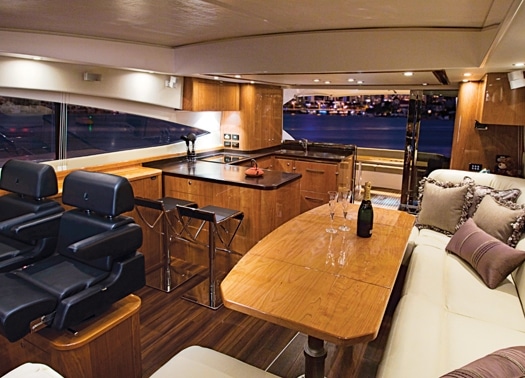
| | |
The starboard helm station is set up for both captain and mate with two seats abaft the well-equipped instrument panel. Gauges were easy to read and accessible. A sliding window not only brings in air underway, but also will allow for commu nication to your line handlers when coming alongside. There is an unflawed 360-degree line of sight from the helm. A massive sunroof opens above. With the after bulkhead recessed, the 5800 turns into an open boat in short order. The engineers did a fine job of ensuring the sunroof doesn’t funnel in too much wind and, thus, vibration.
A stern garage accommodates a 3.2-meter tender and a PWC can also be carried on the hydraulic swim platform. This area was surprising to see considering the accommodations. Nothing was pinched.
The interior volume and execution of details on the 5800 alone would be sufficient to give that wow factor. But the ride and performance are noteworthy indeed. The joystick control and ease of close quarters maneuvering will appeal to couples cruising shorthanded. With one push of the stick sideways, we were off the fuel dock. A twist to port, and we were turned around in the tight basin and heading out to open water.
From idle, we pegged the throttles forward and shot out of the hole like a bow rider towing a skier. No wallowing, no smoke, and no excess noise. My decibel meter was picking up more wind noise than engine noise. We achieved a top speed of 38.3 knots and read 74 decibels at the helm. If you consider that the normal level of conversation is 64 decibels, it’s impressive. Handling was responsive and precise.
Pulling back the throttles to 3400 rpm dropped the speed to 27.2 knots, which would be the high cruise for the 5800. At a speed of 24 knots the combined fuel burn was a very respectable 47 gallons-per-hour. At this speed, with a 700-gallon fuel capacity, the 5800 has a range of 320 miles with a ten percent reserve. If longer legs are required, just pull back a little more.
And chances are, you’ll want to go far. The 5800 Sport Yacht takes the express style design a step further by incorporating all of the cruising comforts of a flying bridge design. Combined with peppy performance and efficiencies, you too will feel wowed after some time on board.
Riviera, **www.riviera.com.au**






